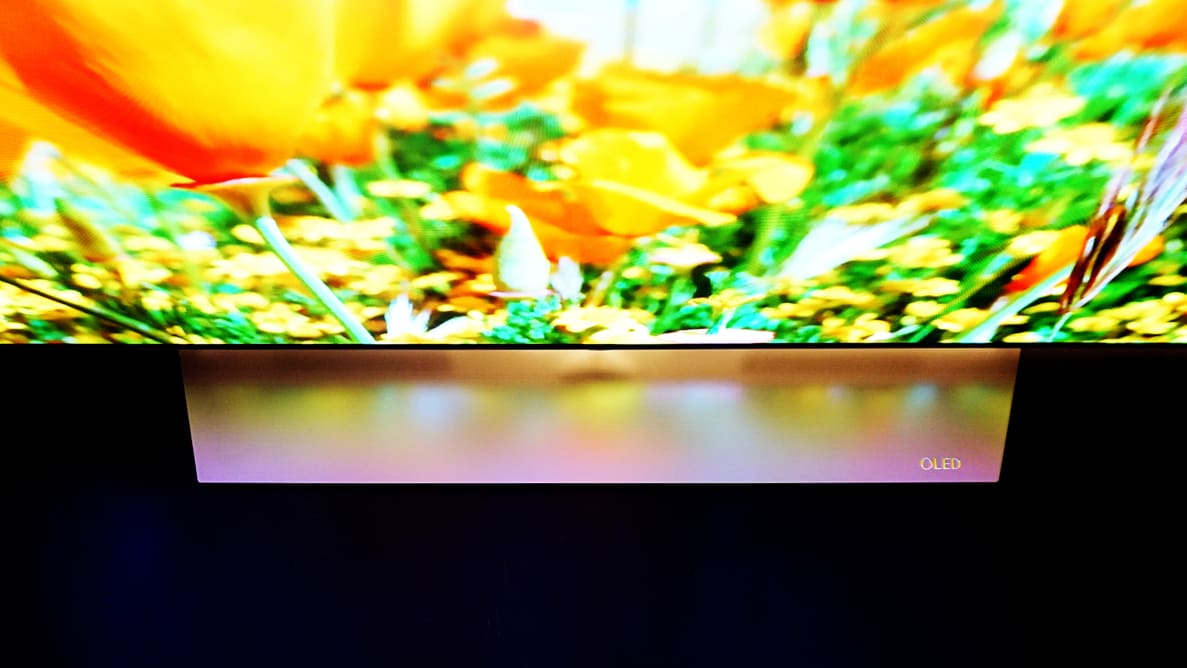In a dark home theater environment, OLED televisions absolutely sing. But as great as these TVs are, there are two major complaints: they're too expensive, and they're all curved. While the prices are starting to come down on this new technology, LG is finally ditching the curve for its first flat 4K OLED, the LG 65EF9500 (MSRP $5,999).
The EF9500 is practically identical to its curved sibling, the EG9600 series, according to our test results: the EF9500 looks incredible, boasting pitch-black shadows and vibrant colors. In addition to a near-perfect picture, you'll get HDR compatibility, LG's new webOS 2.0, and a surprisingly fetching physical design. The EF9500 really is the total package, and it's easily one of our favorite TVs of the year.
Series Information
LG's flat OLED comes in two sizes: big and bigger.
LG's EF9500 flat 4K OLED TVs are available in two sizes: a 55-inch set (LG 55EF9500, MSRP: $3,999) and the 65-inch size that we tested in our labs (LG 65EF9500, MSRP: $5,999). The two TVs are identical in terms of feature set and panel type, so performance should be similar across both.
{{amazon name="LG 65EF9500 65-Inch 4K Ultra HD Smart OLED TV (2015 Model)", asin="B010RX0UKY", align="left"}} Other than the lack of curvature, the EF9500 flat 4K OLED TVs are nearly identical to LG's EG9600 4K OLEDs, and are available for the same price currently.
The 65EF9500 that we tested was received on-loan from LG. It was reset to factory defaults and given roughly 50 hours of warm up and break-in time prior to review. During this time, the TV displayed some image retention issues that have been common amongst OLED TVs, but nothing permanent.
Design & Hardware
Flat at last! Flat at last!
Contrary to popular belief, OLED TVs never needed to be curved. The initial curvature was probably done in order to show off the "flexible" nature of OLED technology, since explaining emissive substrates and organic diodes is probably above the pay grade for most of Best Buy's staff.
But the curve trend caught on, and even non-OLED models started jumping on the bend bandwagon. Fortunately, it appears to be a passing fad: LG's EF9500 is as flat as they come, and it looks just as good (if not better) than the curved EG9600, which is otherwise identical.
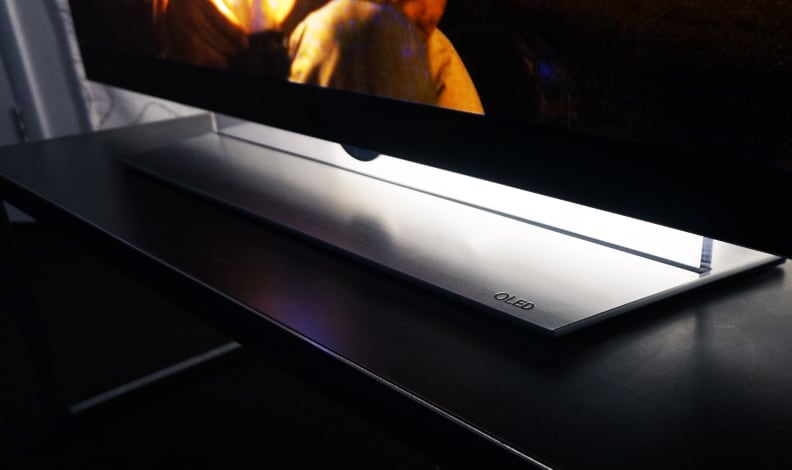
The 65-inch EF9500 Flat OLED sets upon a flat metal stand that connects to the panel via a transparent segment. In a dark room, the screen appears to float.
Like other OLED TVs, the EF9500 is ghastly thin, with most of the panel about as thick as a pencil. The almost bezel-free screen perches atop an equally svelte and minimal silver stand. The two are connected by a band of clear plastic, giving the TV the appearance that it floats in mid-air.
Like the EG9600, the EF9500 sports a white rear casing, rather than the usual charcoal black you'll find on 99% of TVs. It makes for a TV that stands out in a brightly-lit room—ironic, since this TV should be the centerpiece of a dark home theater.
And it's not all aesthetics back here, either. You'll find both on-set controls and AV ports, including three HDMI 2.0 inputs, three USB 3.0/2.0 inputs, splitters for component/composite hookups, a coaxial jack a LAN (ethernet) input, optical audio, and an RS-232c control port.
Lastly, LG threw in the latest iteration of its signature motion-based, infrared controller, i.e. the Magic Remote. As TVs have gotten "smarter," companies have taken to including two remotes with their high-end sets—one traditional clicker and one with a touchpad for entering passwords and the like. You know, because everyone likes having more remotes laying around.
{{ photo_gallery "design" }}
LG's Magic Remote is designed to work well as both, providing you with traditional hardware buttons while also letting you point it at the screen to operate an on-screen cursor. It's clumsier than other methods, but it's effective, letting you enter passwords quicker than you could with the clicker alone.
All in all, it's the best way to navigate LG's webOS 2.0 smart platform. It can be a little slow to wake up at times, but LG's made up for that by making the entire experience much snappier.
Software & Smart Features
LG's webOS 2.0 continues to impress, though it won't outdo a dedicated set-top-box.
You might be paying a lot for the EF9500, but LG throws in plenty of goodies via the webOS 2.0 smart platform. LG's webOS took our award last year for Best Smart Platform, and not much has changed for the 2.0 update—it's faster, but otherwise it's the same system we know and love.
The most notable thing about webOS is how fun and bubbly it is. Where many smart platforms are choppy and difficult to use, webOS manages to spruce up the experience with friendly cartoon characters, easy-to-follow setup instructions, and lots of helpful prompts.
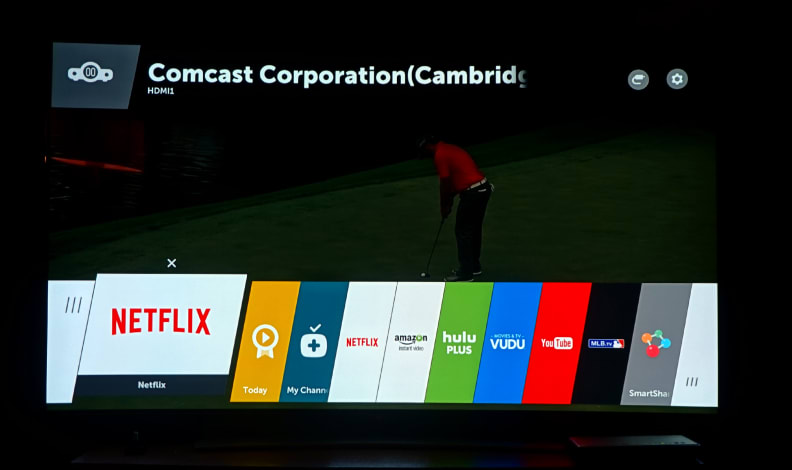
LG's webOS 2.0 is a smooth, minimalist smart experience that boots up quickly and works very well with the signature Magic Remote.
The new webOS looks (and behaves) almost identically to last year's version. Bring up the main app hub and you'll find favorites like Netflix and Hulu Plus lined up in neat diagonal wedges at the bottom of the screen. You'll also find shortcuts to frequently used items, letting you quickly move from one app, to another, to traditional inputs like your TV antenna or cable box.
If you want a more all-encompassing look you can expand this view, giving more real estate to each option so you know what it's all about. You can manually customize which apps appear here or let webOS do the work, automatically pulling the apps you use most into this quick launch bar.
For content webOS 2.0 offers a variety of options, including Netflix, Amazon Instant Video, and YouTube—all of which stream native 4K content—as well as popular options like Facebook and Twitter. There's lots more in the LG app store, too, but we imagine the ones you'll use the most are all pre-installed already.
{{ photo_gallery "software" }}
You also get a ton of options for customizing both display and audio, which is customary for LG's top-end TVs. You'll find the usual spread of picture and sound modes, plus the full array of advanced calibration options like 2- and 10-point white balance controls and a Color Management System (CMS).
While these controls won't be necessarily useful to the everyday viewer, they do allow a trained calibration specialist to tweak the finest details of the TV's picture quality. Calibration will help to push the EF9500 to its limit, and you can find the calibration settings that we used on our test results page.
Picture Quality & Viewing
The EF9500 provides jaw-dropping image quality and puts questions about OLED to bed.
OLED TVs have consistently been among our top-performing TVs for the past two years thanks to their ability to render nearly perfect black levels, providing incredible levels of contrast. This is because while conventional LED/LCD TVs use a backlight to produce an image, OLED televisions are "emissive" displays. Like plasma TVs, this means that each individual pixel is creating its own light, allowing it to turn off when not in use.
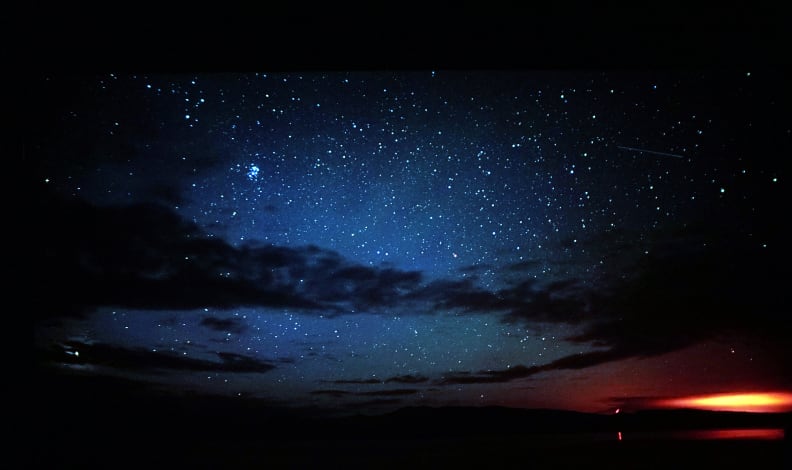
Each OLED pixel turns on and off independently from one another, making for incredible contrast and step definition between different levels of luminance on the screen. Think of it like the ultimate full-array backlight.
Since contrast is considered the crucial component of a truly cinematic presentation, OLED TVs have a built-in advantage. The EF9500 is no exception: I measured the same nigh infinite black level as every other OLED we've tested. When a scene in a movie calls for black, this TV delivers.
For example, while watching a movie like Ridley Scott's Alien, the deep blacks of space melt into the background—especially when watched in a dark room. On a conventional TV the blackest part of the scene will still have some luminance, giving it a flat appearance that isn't as immersive. This gives the picture a life-like, three-dimensional appearance.
Enhancing contrast is also a chief reason why so many TV manufacturers are gunning for HDR (High Dynamic Range) capability. LG claims both the flat EF9500 and the curved EG9600 are HDR-compatible, but the lack of HDR content makes that difficult to judge. It's safe to say both TVs will be relying on their deep blacks to achieve the effect, as neither comes anywhere near the brightness capabilities of sets like Samsung's HDR-ready JS9000.

The EF9500's shadow production is best-in-class—the OLED cells shut off entirely, making everything that's on look brighter and more colorful by contrast.
Of course, not every OLED TV is perfect simply because they have great black levels. In fact, previous OLEDs have exhibited some flaws that drive picky viewers nuts. Many of these problems go away over time, but that can take dozens of hours to happen. Luckily, the EF9500 addresses these issues head-on, providing some of the best out-of-the-box performance we've seen from an OLED yet.
The biggest issue we've had with OLED sets is their lack of uniformity. Take most OLEDs out of the box and you'll find that certain sections of the screen are brighter than others. This usually crops up in the form of vignetting, with darker-than-usual corners. This is great on a photograph, not so much with your TV.
With the EF9500, we saw almost no uniformity issues. This meant we had to spend less time "breaking in" the TV, though after a few days we did see some notable improvement. We still gave it about 50 hours of screen on time prior to testing, so you'll want to plan accordingly if you pick it up.

The EF9500 handles subtler luminance allocation quite well, and matched even Keith Richards' unique skin tone with aplomb.
The other major issue we've seen with past OLED TVs is in how smoothly they transition from deep blacks to bright whites. This luminance curve—called "gamma"—determines the amount of detail you can see in the shadows. On a movie like The Dark Knight a TV with proper gamma will let you see the small details in the various night scenes, like the indigo in The Joker's bespoke suit.
This is another area where the EF9500 has improved greatly. Though it was still a bit off the mark in some highlights, in general the TV transitioned very smoothly across the luminance range. I found this especially visible when watching Alien, where you have a highly detailed practical environment, a huge variety of different light sources, and a director that makes incredible use of shadows. On some sets the huge dynamic range of the original film can get flattened out, but on the EF9500 it's remarkably cinematic.
Viewing Experience
Simply put, the EF9500 Flat OLED is the best-looking TV we've seen in some time. It boasts all the same strengths as LG's curved 4K OLEDs, with a few key improvements, too. And after a little tinkering and calibrating, it's a worthy centerpiece to any home theater.

After calibration, the EF9500 exhibited spot-on accuracy, producing very realistic renditions of sunlight, leaves, and wet grass coloration.
Basically, regardless of what I watched, the EF9500 looked awesome. The inky, lightless black levels not only make for amazing contrast, but they keep "light pollution" out of colors, making them look more pure and vibrant by comparison. Combined with the EF9500's improved shadow detail performance compared to past sets, this makes for very striking, accurate movies and TV.
Streaming 4K off of YouTube, Blu-ray discs, and even HD cable looks excellent. However, the latter can be dodgy considering the EF9500 is a 4K/UHD TV and must "upscale" (recreate) pixels whenever it's playing less-than-4K resolution content. Because of this, the EF9500 definitely looks best when streaming or playing on-disc 1080p (Blu-ray) content and transfers, as it doesn't have to do as much guesswork.
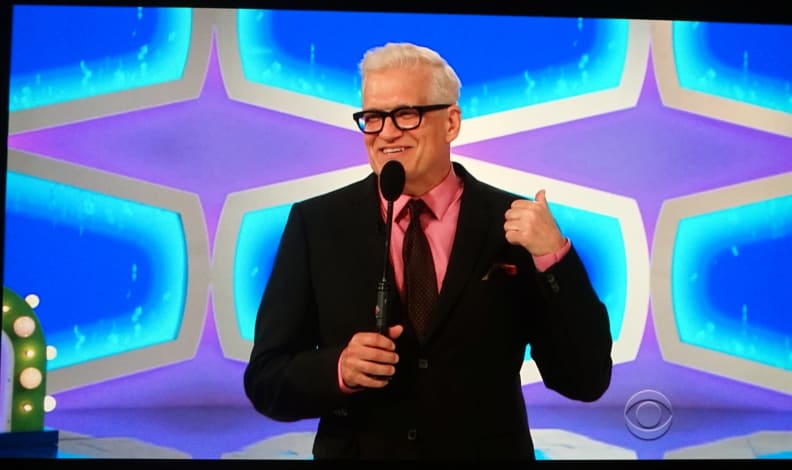
The EF9500 upscales sub-4K content well—though with any 4K TV, 720p content like this can look fuzzy at times, so 1080p or native 4K are still you best bets.
To really get a feel for what sets an OLED like the EF9500 apart from traditional LED sets, we recommend watching some dark, filmic content. While it's not as new as it once was, I still prefer Nolan's The Dark Knight for this very reason, as it includes not only a good mix of dark/bright scenes, but also a mix of fullscreen and "letterbox" (16:9 with black bars).
The fight between the Joker and Batman in the latter half of the film is especially striking on an OLED. The mix of bright, pinpoint highlights—like in the Joker's pupils as he looks up, hanging out of the building—with the subtle, dark purple shades of his suit standing out amongst inky shadows makes for a near-HDR appearance at times.
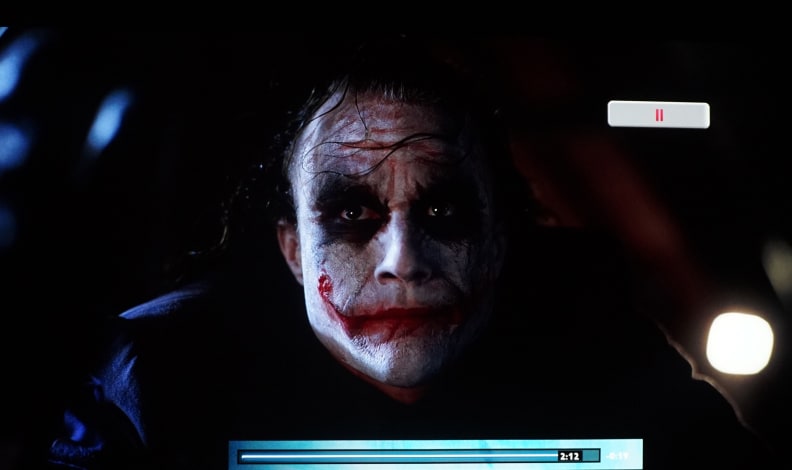
The EF9500 exhibited much better dark room shadow detail than past sets, preserving subtle details while still capturing an HDR-like level of specular brightness.
Motion performance is one area where the EF9500 is still in the "average" category, though. The TV compares well with the best LCDs, but it falls well behind the top plasmas of yesteryear. Make no mistake, though—the EF9500 is still on-par with the best LCD sets on the market in terms of motion, so the majority of viewers aren't going to have any complaints.

The EF9500 produces just a little extra color, adding some punch to the brown/blue-heavy Mad Max without stepping out of the bounds into tasteless oversaturation.
Finally, it's worth pointing out that while the 65-inch EF9500 falls a little short of last year's 65EC9700, the difference between the two is almost negligible. The EC9700 tested with an impeccable out-of-the-box calibration, exhibiting just a little more color and gray-tone accuracy than the EF9500. This is the kind of thing you'd almost never see without professional meters, however, and is almost purely a technical differentiation.
Want to check out the pre- and post-calibration results and charts? Head to the Science Page.
The Verdict
Once you go flat, you never go back.
There's nothing inherently wrong with curved TVs. While some people prefer the aesthetics of a curved display, there isn't an obvious, objective argument for or against them. There is an argument for having options, however, and if you wanted an OLED until now you've been forced to live with the curve.
With the LG 65EF9500 and the 55EF9500, that's no longer the case. These flat 4K OLEDs have all the same performance advantages of LG's best OLED displays, but don't stick you with a curved panel that you may not want. Add to that the improved webOS 2.0 smart platform, a fetching design, and HDR compatibility and you've got one of the top TVs of 2015.
But the flat display isn't the only thing that makes the EF9500 such a great performer. LG has also clearly done some homework, and has greatly improved on the major issues that have dogged previous OLEDs: unsightly panel uniformity issues and near-black shadow detail. Those issues haven't been entirely solved, but they're greatly improved.
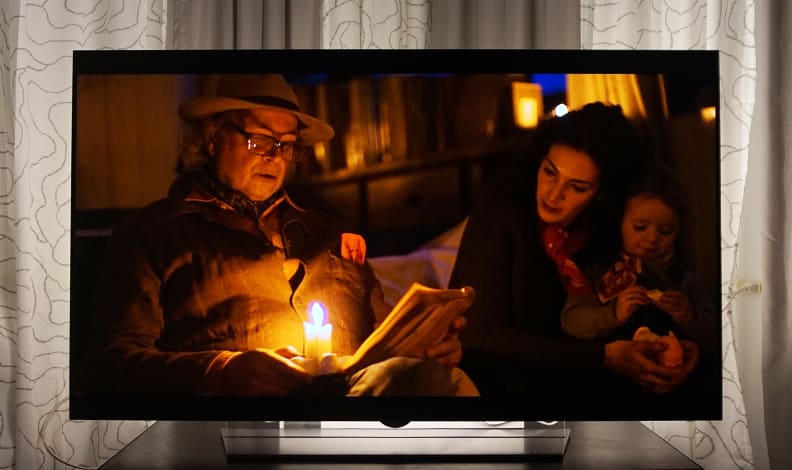
And let's be honest, those gripes are tiny, likely only to bug the staunchest videophiles. The fact of the matter is this is one of the best-performing TVs we've ever seen. Especially for movie lovers with a top-notch home theater setup, the LG EF9500 is an ideal way to watch your favorite films, with inky blacks, exceptional tonal and color accuracy, and future-proof features like 4K resolution and HDR compatibility.
Of course, the one major complaint about OLED TVs still remains: the price. At $6,000 the 65EF9500 is still well out of the reach of most people. It's cheaper than previous OLEDs and not that far above flagship LCD TVs, but this is the one area where OLED still has a long way to go.
Who knows? Maybe you're actually considering buying it. Or maybe you're just going to gaze longingly at it whenever you visit your local electronics store. Either way, this will probably be the best TV you've ever laid eyes on. As LG's newest 4K OLED—and the first real flat one—the 65EG9600 (MSRP $5,999) has some big shoes to fill. Fortunately, it tested with the same great contrast, color accuracy, and horizontal viewing angle we've come to expect from OLED models.
It also exhibited a high degree of gamma accuracy (at least compared to the 2013 sets), and was much easier to calibrate, with less measurement shifting during on-screen menus.
Below, you'll find LG's defaults for the ISF Expert1 picture mode, alongside my final calibration settings, and the pre- post-calibration results further down.
Calibration
The EF9500 was easier to calibrate than any other OLED before it. Unlike past OLEDs, I found that the TV's measurements and luminance readings didn't change much when the menu interface was on or off the screen, making it much easier to dial in accurate settings in a short amount of time.
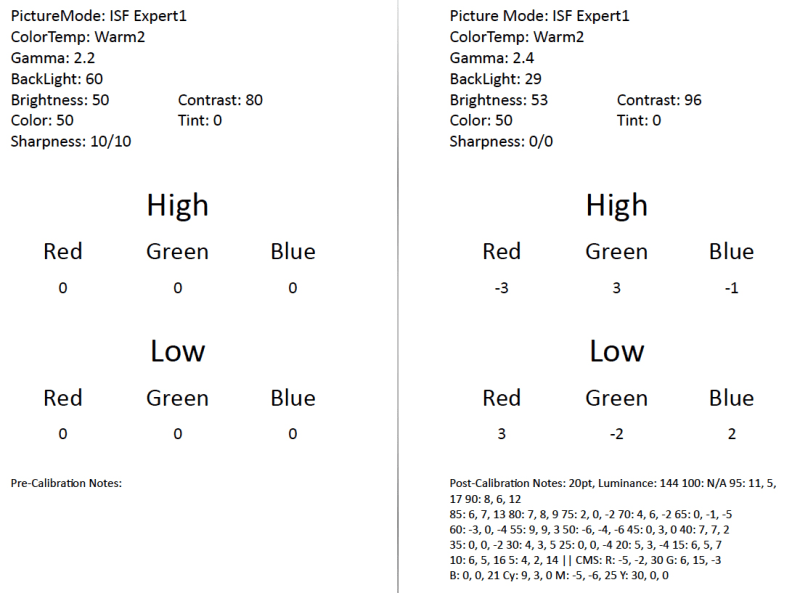
Contrast Ratio
The EF9500 tested with a massive ANSI contrast ratio if 143,700:1, with a (calculated) black level of 0.001 and a reference ANSI brightness of 143.70 in the ISF Expert1 picture mode. This compares very similarly to the curved EG9600.

Viewing Angle
As usual the EF9500 boasts an extremely wide viewing angle, with a total of 166°, or ±83° from the center to either side of the screen. This is well beyond what most LCD TVs can do, but right in line with the OLED crop.
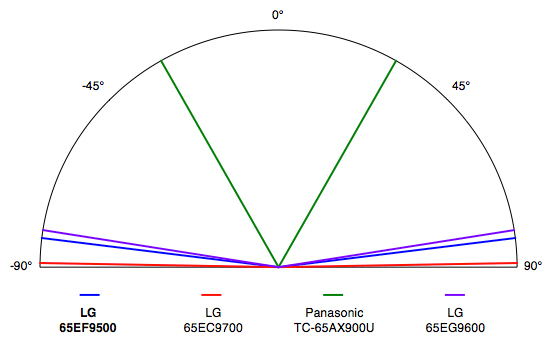
Gamma
Prior to calibration, the EF9500 tested with a mostly flat, even 2.25 gamma, which is close to the 2.2 ideal it has been calibrated to in the ISF Expert1 picture mode. After calibration, I ended with a very flat 2.36 gamma, very close to the 2.4 dim/dark room ideal.
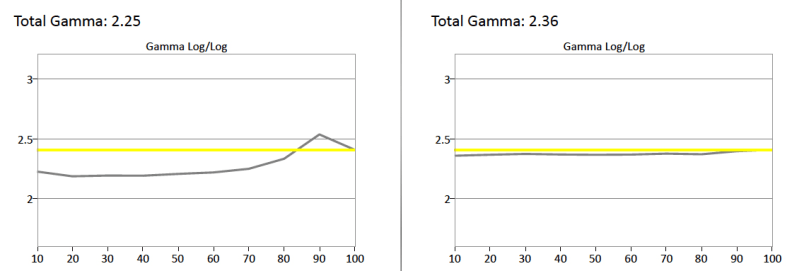
RGB Balance & Grayscale
Like previously OLEDs, the EF9500's out-of-the-box grayscale tracking is quite good, albeit not entirely perfect. Fortunately, it was no trouble to use LG's 2/20 point white balance controls to tighten up the RGB emphasis and decrease the grayscale deltaE from 4.29 (a little over the 3 dE ideal) to 1.11.
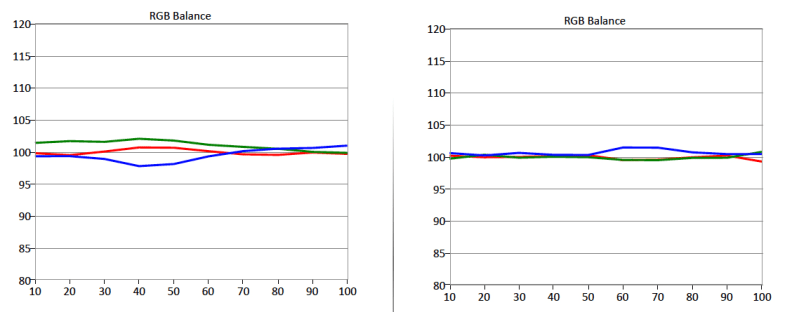

Color Accuracy
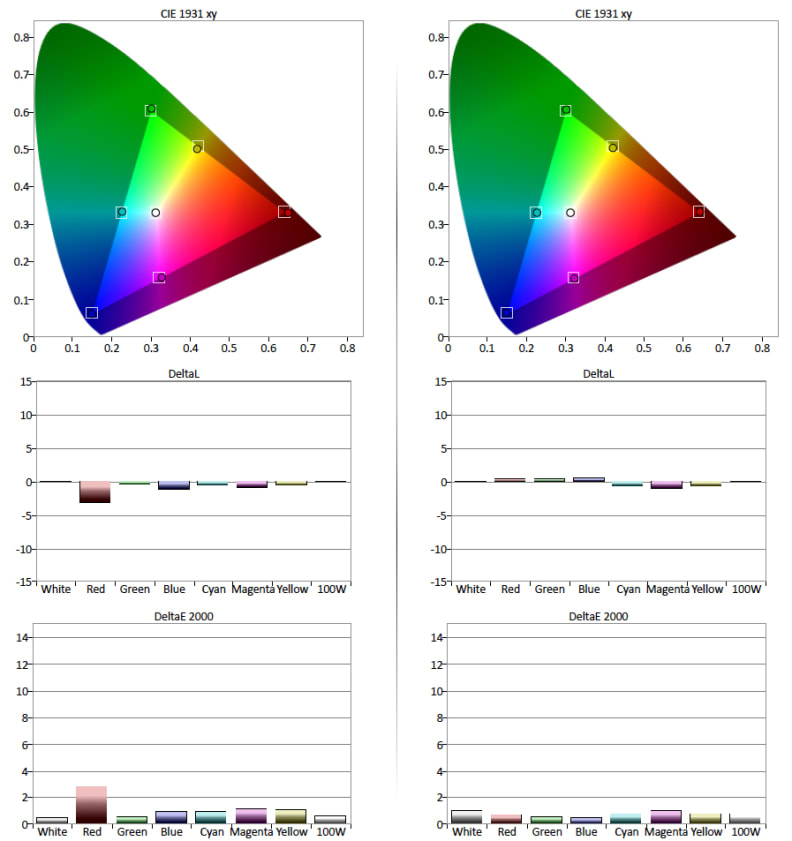
Meet the testers
Mark Brezinski works on the Home Team, reviewing refrigerators, minifridges, dishwashers, washing machines, dryers, air conditioners, air purifiers, and fans.
Lee was Reviewed's point person for most television and home theater products from 2012 until early 2022. Lee received Level II certification in TV calibration from the Imaging Science Foundation in 2013. As Editor of the Home Theater vertical, Lee oversaw reviews of TVs, monitors, soundbars, and Bluetooth speakers. He also reviewed headphones, and has a background in music performance.
Checking our work.
Our team is here for one purpose: to help you buy the best stuff and love what you own. Our writers, editors, and lab technicians obsess over the products we cover to make sure you're confident and satisfied. Have a different opinion about something we recommend? Email us and we'll compare notes.
Shoot us an email


